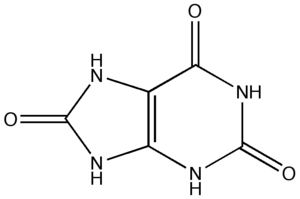The enzyme urate oxidase (UO), or uricase or factor-independent urate hydroxylase, absent in humans, catalyzes the oxidation of uric acid to 5-hydroxyisourate:[2]
- Uric acid + O2 + H2O → 5-hydroxyisourate + H2O2
- 5-hydroxyisourate + H2O → allantoin + CO2
Structure
Urate oxidase is mainly localised in the liver, where it forms a large electron-dense paracrystalline core in many peroxisomes.[3] The enzyme exists as a tetramer of identical subunits, each containing a possible type 2 copper-binding site.[4]
Urate oxidase is a homotetrameric enzyme containing four identical active sites situated at the interfaces between its four subunits. UO from A. flavus is made up of 301 residues and has a molecular weight of 33438 daltons. It is unique among the oxidases in that it does not require a metal atom or an organic co-factor for catalysis. Sequence analysis of several organisms has determined that there are 24 amino acids which are conserved, and of these, 15 are involved with the active site.
Significance of absence in humans
Of all animals that include meat in their diet, humans are the only animal that is unable to break down uric acid to allantoin. This is due to the fact that humans do not possess the necessary enzyme uricase. This leads to an increased possibility of an accumulation of uric acid in the body when animal products are eaten.
Humans do have a gene for urate oxidase, but it is nonfunctional. Thus uric acid is the end product of catabolism of purines in humans. Excessive concentration of uric acid in the blood stream leads to gout.
Urate oxidase is found in nearly all organisms, from bacteria to mammals, and plays different metabolic roles, depending on its host organism. It was lost in early primate evolution,[4] and so is absent in humans and other higher apes.
It has been proposed that the loss of urate oxidase gene expression has been advantageous to hominids, since uric acid is a powerful antioxidant and scavenger of singlet oxygen and radicals.[5] Its presence provides the body with protection from oxidative damage, thus prolonging life and decreasing age-specific cancer rates.
Urate oxidase is formulated as a protein drug (rasburicase) for the treatment of acute hyperuricemia in patients receiving chemotherapy. A PEGylated form of urate oxidase, pegloticase, was FDA approved in 2010 for the treatment of chronic gout in adult patients refractory to "conventional therapy".[6]
In legumes
UO is also an essential enzyme in the ureide pathway, where nitrogen fixation occurs in the root nodules of legumes. The fixed nitrogen is converted to metabolites that are transported from the roots throughout the plant to provide the needed nitrogen for amino acid biosynthesis.
In legumes, 2 forms of uricase are found: in the roots, the tetrameric form; and, in the uninfected cells of root nodules, a monomeric form, which plays an important role in nitrogen-fixation.[7]
References
- ↑ "Human PubMed Reference:".
- ↑ Motojima K, Goto S, Kanaya S (1988). "Cloning and sequence analysis of cDNA for rat liver uricase". J. Biol. Chem. 263 (32): 16677–16681. PMID 3182808.
- ↑ Motojima K, Goto S (1990). "Organization of rat uricase chromosomal gene differs greatly from that of the corresponding plant gene". FEBS Lett. 264 (1): 156–158. PMID 2338140. doi:10.1016/0014-5793(90)80789-L.
- 1 2 Lee CC, Caskey CT, Wu XW, Muzny DM (1989). "Urate oxidase: primary structure and evolutionary implications". Proc. Natl. Acad. Sci. U.S.A. 86 (23): 9412–9416. PMC 298506
 . PMID 2594778. doi:10.1073/pnas.86.23.9412.
. PMID 2594778. doi:10.1073/pnas.86.23.9412. - ↑ Ames BN, Cathcart R, Schwiers E, Hochstein P (November 1981). "Uric acid provides an antioxidant defense in humans against oxidant- and radical-caused aging and cancer: a hypothesis". Proc. Natl. Acad. Sci. U.S.A. 78 (11): 6858–62. PMC 349151
 . PMID 6947260. doi:10.1073/pnas.78.11.6858.
. PMID 6947260. doi:10.1073/pnas.78.11.6858. - ↑ "Pegloticase Drug Approval Package". US FDA. Retrieved 15 May 2017.
- ↑ Nguyen T, Zelechowska M, Foster V, Bergmann H, Verma DP (1985). "Primary structure of the soybean nodulin-35 gene encoding uricase II localized in the peroxisomes of uninfected cells of nodules". Proc. Natl. Acad. Sci. U.S.A. 82 (15): 5040–5044. PMC 390494
 . PMID 16593585. doi:10.1073/pnas.82.15.5040.
. PMID 16593585. doi:10.1073/pnas.82.15.5040.
|
|---|
| Activity | |
|---|
| Regulation | |
|---|
| Classification | |
|---|
| Kinetics | |
|---|
| Types | |
|---|
This article incorporates text from the public domain Pfam and InterPro IPR002042
 . PMID 2594778. doi:10.1073/pnas.86.23.9412.
. PMID 2594778. doi:10.1073/pnas.86.23.9412. . PMID 6947260. doi:10.1073/pnas.78.11.6858.
. PMID 6947260. doi:10.1073/pnas.78.11.6858. . PMID 16593585. doi:10.1073/pnas.82.15.5040.
. PMID 16593585. doi:10.1073/pnas.82.15.5040.

